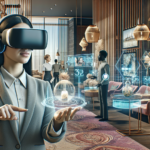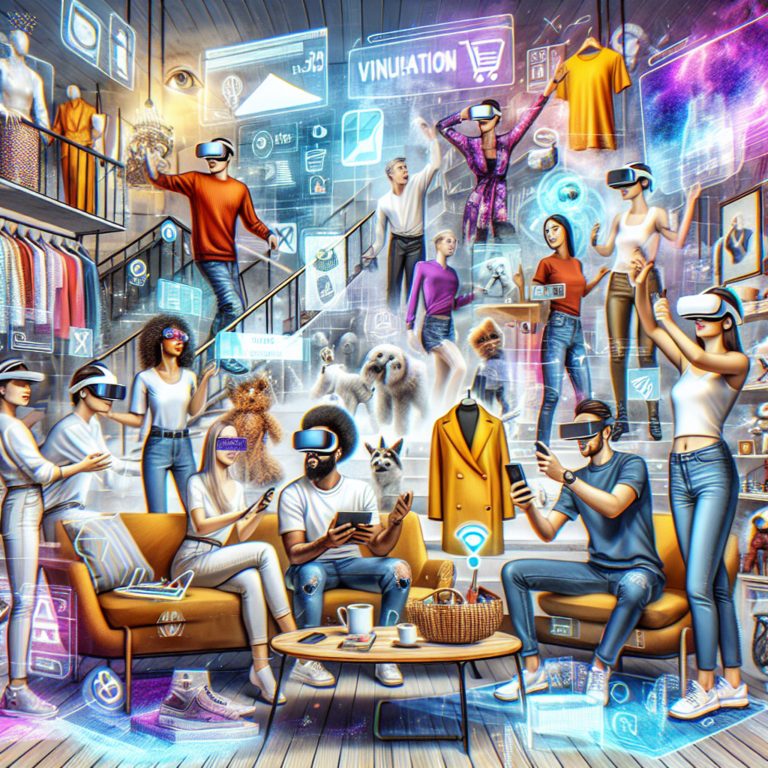Revolutionizing Online Shopping: The Magic of Immersive Technologies ✨
Introduction: A New Era in E-Commerce
In recent years, immersive technologies have begun to play a pivotal role in the landscape of online shopping, transforming the way consumers interact with products. Virtual Reality (VR), Augmented Reality (AR), and mixed reality experiences are not just buzzwords; they are tools reshaping our shopping habits and expectations. This blog explores how these cutting-edge technologies are enhancing the online shopping experience and what it means for consumers and retailers alike.
Understanding Immersive Technologies
Before diving into their impact on online shopping, it’s essential to grasp what immersive technologies entail:
- Virtual Reality (VR): A fully immersive experience that transports users into a digital world where they can interact with 3D models of products.
- Augmented Reality (AR): This technology overlays digital elements onto the real world, enabling users to see how products would look in their environment.
- Mixed Reality (MR): A blend of both AR and VR, where physical and digital objects coexist and interact in real-time.
Enhancing Product Visualization
Bringing Products to Life
One of the most significant advantages of immersive technologies is the ability to visualize products before purchasing. Thanks to AR and VR, customers can now experience products in a way that traditional images and videos simply cannot offer. This leads to several benefits:
- Realistic Exposure: Customers can see products from all angles, examining textures and features closely, ensuring they know exactly what they are buying.
- Interactive Experiences: Shoppers can manipulate 3D models, try out virtual versions of clothing, or visualize furniture in their homes, making the shopping experience much more engaging.
Reducing Uncertainty and Returns
With improved visualization comes a significant decrease in product returns. When shoppers can see and even interact with products virtually, they are less likely to experience buyer’s remorse or receive items that don’t meet their expectations. This direct interaction helps build confidence in purchase decisions, ultimately benefiting both consumers and retailers.
Creating Immersive Shopping Environments
The Virtual Store Experience
Imagine walking through a virtual store from the comfort of your home! VR technologies allow retailers to create entire online storefronts that mimic the experience of shopping in a physical store. Customers can browse aisles, pick up items, and interact with virtual sales associates—all from their devices. This brings a sense of excitement and adventure to online shopping that hasn’t been felt before.
Personalized Shopping Journeys
Immersive technologies also pave the way for personalized experiences. Retailers can collect and analyze user data to tailor virtual shopping environments to individual preferences. This includes:
- Custom Layouts: Organizing items based on previous purchasing behavior or preferences.
- Virtual Try-Ons: Allowing customers to try out clothing or accessories using AR to see what looks best on them.
- Real-Time Recommendations: Suggesting similar items or accessories that would complement a chosen product.
Social Shopping Experiences
Shopping with Friends from Afar
Immersive technologies are not just about product interaction; they’re also about enhancing the social aspect of shopping. Virtual environments enable friends and family to join each other in the same online space, regardless of physical location. Users can share their thoughts in real-time, ask for opinions, and make collective purchasing decisions, transforming shopping into a more collaborative and enjoyable experience.
Interactive Live Events
Brands are also utilizing immersive technologies to host live shopping events, creating excitement and a sense of urgency. Imagine participating in a virtual fashion show where viewers can instantly purchase items as they’re showcased! These events foster a community feel while driving sales and keeping customers engaged like never before.
Challenges and Considerations
Technical Hurdles
While the benefits of immersive technologies in online shopping are vast, there are challenges to address:
- Accessibility: Not all consumers have access to the necessary devices or high-speed internet to participate fully in virtual experiences.
- Usability: Some users may find it difficult to navigate new technologies, especially older generations who may not be as tech-savvy.
- Cost: Developing immersive platforms can be expensive for retailers, especially small businesses.
The Balance of Privacy and Personalization
As retailers gather more data to create personalized experiences, they must also be vigilant about privacy concerns. Transparent data collection practices and giving consumers control over their information will be paramount in building trust between shoppers and retailers.
The Future of Online Shopping with Immersive Technologies
The integration of VR, AR, and MR in the online shopping landscape is just beginning. As technology continues to evolve, we can expect even more innovative features and enhancements that bridge the gap between the digital and physical shopping realms. Immersive technologies are not just trends; they are revolutionizing the way we shop online, creating experiences that are engaging, informative, and ultimately more satisfying.
Embracing the Change
As we witness the unfolding transformation in the e-commerce space, it’s clear that immersive technologies hold the potential to redefine consumer habits and expectations. Retailers and consumers alike have much to gain from embracing these advancements, making the future of online shopping an exciting journey full of possibilities!




0 Comments